1.移植目標
將H.264解碼器移植到OPhone操作系統之上(NDK+C),並寫一個測試程序(OPhoneSDK+Java)測試解碼庫是否正常運行,下面是解碼時的截圖:
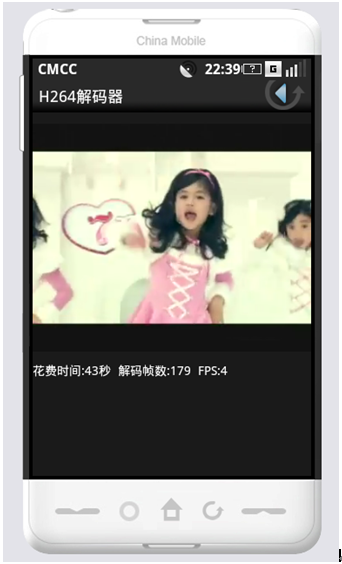
OPhone的模擬器和Mobile的模擬器一樣是模擬ARM指令的,不像Symbian模擬器一樣執行的是本地代碼,所以在模擬器上模擬出來的效率會比真實手機上的效率要低,之前這款解碼器已經優化到在nokia 6600(相當低端的一款手機,CPU主頻才120Hz)上做到在線播放。
2.面向人群
本文面向有一定的手機應用開發經驗(例如:S60/Mobile/MTK)和有一定的跨手機平台移植經驗的人員,幫助她們了解一個企業的核心庫(C/C++)是怎麼移植到OPhone之上的。
3.假定前提
1)熟悉Java/C/C++語言;
2)熟悉Java的JNI技術;
3)有一定的跨手機平台移植經驗;
4)有一套可供移植的源代碼庫,這裡以H.264解碼庫為例,為了保護我們的知識版權,這裡只能夠公開頭文件:
#ifndef __H264DECODE_H__
#define __H264DECODE_H__
#if defined(__SYMBIAN32__) //S602rd/3rd/UIQ
#include <e32base.h>
#include <libc"stdio.h>
#include <libc"stdlib.h>
#include <libc"string.h>
#else //Windows/Mobile/MTK/OPhone
#include <stdio.h>
#include <stdlib.h>
#include <string.h>
#endif
class H264Decode
{
public:
/***************************************************************************/
/* 構造解碼器 */
/* @return H264Decode解碼器實例 */
/***************************************************************************/
static H264Decode *H264DecodeConstruct();
/***************************************************************************/
/* 解碼一幀 */
/* @pInBuffer 指向H264的視頻流 */
/* @iInSize H264視頻流的大小 */
/* @pOutBuffer 解碼後的視頻視頻 */
/* @iOutSize 解碼後的視頻大小 */
/* @return 已解碼的H264視頻流的尺寸 */
/***************************************************************************/
int DecodeOneFrame(unsigned char *pInBuffer,unsigned int iInSize,unsigned char *pOutBuffer,unsigned int &iOutSize);
~H264Decode();
};
#endif // __H264DECODE_H__
你不用熟悉OPhone平台,一切從零開始,因為在此之前,我也不熟悉。
4.開發環境(請參考: http://www.ophonesdn.com/documentation/)
5.移植過程
5.1 移植流程
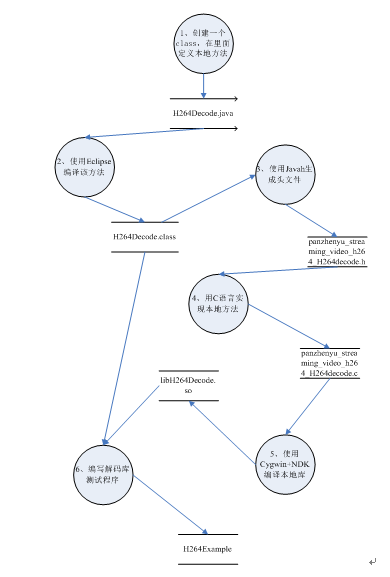
5.2 封裝Java接口
在“假定前提”中提到了要移植的函數,接下來會編寫這些 函數的Java Native Interface。
package ophone.streaming.video.h264;
import java.nio.ByteBuffer;
public class H264decode {
//H264解碼庫指針,因為Java沒有指針一說,所以這裡用一個32位的數來存放指針的值
private long H264decode = 0;
static{
System.loadLibrary("H264Decode");
}
public H264decode() {
this.H264decode = Initialize();
}
public void Cleanup() {
Destroy(H264decode);
}
public int DecodeOneFrame(ByteBuffer pInBuffer,ByteBuffer pOutBuffer) {
return DecodeOneFrame(H264decode, pInBuffer, pOutBuffer);
}
private native static int DecodeOneFrame(long H264decode,ByteBuffer pInBuffer,ByteBuffer pOutBuffer);
private native static long Initialize();
private native static void Destroy(long H264decode);
}
這塊沒什麼好說的,就是按照H264解碼庫的函數,封裝的一層接口,如果你熟悉Java JNI,會發現原來是這麼類似。這裡插入一句:我一直認為技術都是相通的,底層的技術就那麼幾種,學懂了,其它技術都是一通百通。
5.3 使用C實現本地方法
5.3.1生成頭文件
使用javah命令生成JNI頭文件,這裡需要注意是class路徑不是源代碼的路徑,並且要加上包名:
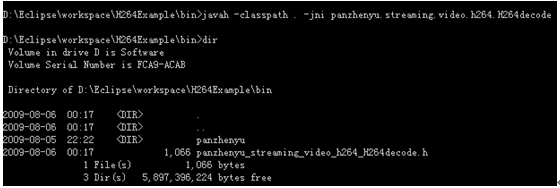
這裡生成了一個ophone_streaming_video_h264_H264decode.h,我們打開來看看:
#include <jni.h>
#ifndef _Included_ophone_streaming_video_h264_H264decode
#define _Included_ophone_streaming_video_h264_H264decode
#ifdef __cplusplus
extern "C" {
#endif
JNIEXPORT jint JNICALL Java_ophone_streaming_video_h264_H264decode_DecodeOneFrame
(JNIEnv *, jclass, jlong, jobject, jobject);
JNIEXPORT jlong JNICALL Java_ophone_streaming_video_h264_H264decode_Initialize
(JNIEnv *, jclass);
JNIEXPORT void JNICALL Java_ophone_streaming_video_h264_H264decode_Destroy
(JNIEnv *, jclass, jlong);
#ifdef __cplusplus
}
#endif
#endif
5.3.2 實現本地方法
之前已經生成了JNI頭文件,接下來只需要實現這個頭文件的幾個導出函數,這裡以H264解碼器的實現為例:
#include "ophone_streaming_video_h264_H264decode.h"
#include "H264Decode.h"
JNIEXPORT jint JNICALL Java_ophone_streaming_video_h264_H264decode_DecodeOneFrame
(JNIEnv * env, jclass obj, jlong decode, jobject pInBuffer, jobject pOutBuffer) {
H264Decode *pDecode = (H264Decode *)decode;
unsigned char *In = NULL;unsigned char *Out = NULL;
unsigned int InPosition = 0;unsigned int InRemaining = 0;unsigned int InSize = 0;
unsigned int OutSize = 0;
jint DecodeSize = -1;
jbyte *InJbyte = 0;
jbyte *OutJbyte = 0;
jbyteArray InByteArrary = 0;
jbyteArray OutByteArrary = 0;
//獲取Input/Out ByteBuffer相關屬性
{
//Input
{
jclass ByteBufferClass = env->GetObjectClass(pInBuffer);
jmethodID PositionMethodId = env->GetMethodID(ByteBufferClass,"position","()I");
jmethodID RemainingMethodId = env->GetMethodID(ByteBufferClass,"remaining","()I");
jmethodID ArraryMethodId = env->GetMethodID(ByteBufferClass,"array","()[B");
InPosition = env->CallIntMethod(pInBuffer,PositionMethodId);
InRemaining = env->CallIntMethod(pInBuffer,RemainingMethodId);
InSize = InPosition + InRemaining;
InByteArrary = (jbyteArray)env->CallObjectMethod(pInBuffer,ArraryMethodId);
InJbyte = env->GetByteArrayElements(InByteArrary,0);
In = (unsigned char*)InJbyte + InPosition;
}
//Output
{
jclass ByteBufferClass = env->GetObjectClass(pOutBuffer);
jmethodID ArraryMethodId = env->GetMethodID(ByteBufferClass,"array","()[B");
jmethodID ClearMethodId = env->GetMethodID(ByteBufferClass,"clear","()Ljava/nio/Buffer;");
//清理輸出緩存區
env->CallObjectMethod(pOutBuffer,ClearMethodId);
OutByteArrary = (jbyteArray)env->CallObjectMethod(pOutBuffer,ArraryMethodId);
OutJbyte = env->GetByteArrayElements(OutByteArrary,0);
Out = (unsigned char*)OutJbyte;
}
}
//解碼
DecodeSize = pDecode->DecodeOneFrame(In,InRemaining,Out,OutSize);
//設置Input/Output ByteBuffer相關屬性
{
//Input
{
jclass ByteBufferClass = env->GetObjectClass(pInBuffer);
jmethodID SetPositionMethodId = env->GetMethodID(ByteBufferClass,"position","(I)Ljava/nio/Buffer;");
//設置輸入緩沖區偏移
env->CallObjectMethod(pInBuffer,SetPositionMethodId,InPosition + DecodeSize);
}
//Output
{
jclass ByteBufferClass = env->GetObjectClass(pOutBuffer);
jmethodID SetPositionMethodId = env->GetMethodID(ByteBufferClass,"position","(I)Ljava/nio/Buffer;");
//設置輸出緩沖區偏移
env->CallObjectMethod(pOutBuffer,SetPositionMethodId,OutSize);
}
}
//清理
env->ReleaseByteArrayElements(InByteArrary,InJbyte,0);
env->ReleaseByteArrayElements(OutByteArrary,OutJbyte,0);
return DecodeSize;
}
JNIEXPORT jlong JNICALL Java_ophone_streaming_video_h264_H264decode_Initialize
(JNIEnv * env, jclass obj) {
H264Decode *pDecode = H264Decode::H264DecodeConstruct();
return (jlong)pDecode;
}
JNIEXPORT void JNICALL Java_ophone_streaming_video_h264_H264decode_Destroy
(JNIEnv * env, jclass obj, jlong decode) {
H264Decode *pDecode = (H264Decode *)decode;
if (pDecode)
{
delete pDecode;
pDecode = NULL;
}
}
5.3.3 編譯本地方法
接下來,只需要把用C實現的本地方法編譯為動態鏈接庫,如果之前你用於移植的那個庫曾經移植到Symbian上過,那麼編譯會相當簡單,因為NDK的編譯器和Symbian的編譯器一樣,都是采用GCC做交叉編譯器。
首先,需要在$NDK"apps目錄下,創建一個項目目錄,這裡創建了一個H264Decode目錄,在H264Decode目錄中,創建一個Android.mk文件:
APP_PROJECT_PATH := $(call my-dir)
APP_MODULES := H264Decode
接下來,需要在$NDK"source目錄下,創建源代碼目錄(這裡的目錄名要和上面創建的項目目錄文件名相同),這裡創建一個H264Decode目錄,然後把之前生成的JNI頭文件和你實現的本地方法相關頭文件和源代碼,都拷貝到 這個目錄下面。
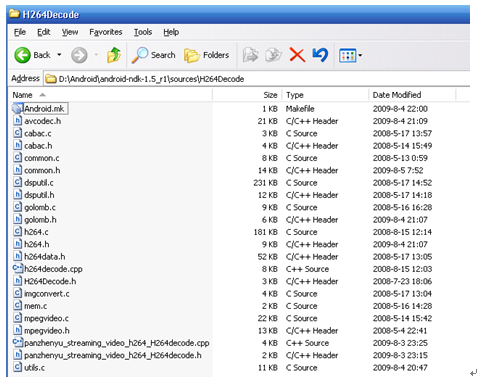
然後,我們編輯Android.mk文件:
LOCAL_PATH := $(call my-dir)
include $(CLEAR_VARS)
LOCAL_MODULE := H264Decode
LOCAL_SRC_FILES := common.c cabac.c utils.c golomb.c mpegvideo.c mem.c imgconvert.c h264decode.cpp h264.c dsputil.c ophone_streaming_video_h264_H264decode.cpp
include $(BUILD_SHARED_LIBRARY)
關於Android.mk文件中,各個字段的解釋,可以參考$NDK"doc下的《OPHONE-MK.TXT》和《OVERVIEW.TXT》,裡面有詳細的介紹。
最後,我們啟動Cygwin,開始編譯:
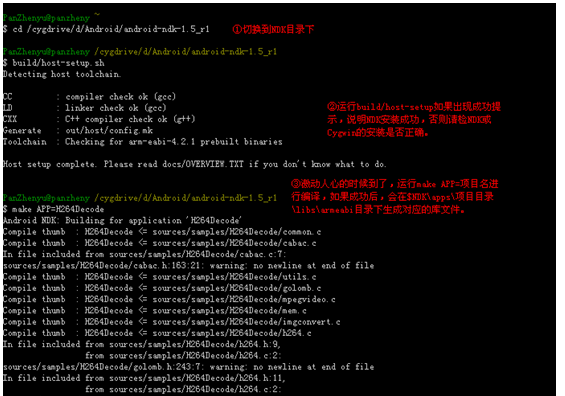
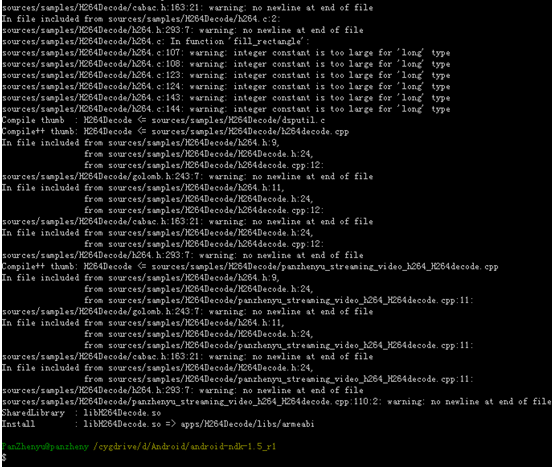
如果你看到了Install:**,這說明你的庫已經編譯好了。
FAQ 2:
如果編譯遇到下面錯誤,怎麼辦?
error: redefinition of typedef 'int8_t'
需要注釋掉你的代碼中“typedef signed char int8_t;”,如果你的代碼之前是已經移植到了Mobile/Symbian上的話,很有可能遇到這個問題。
5.4 編寫庫測試程序
用Eclipse創建一個OPhone工程,在入口類中輸入如下代碼:
/**
* @author ophone
* @email [email protected]
*/
package ophone.streaming.video.h264;
import java.io.File;
import java.io.FileInputStream;
import java.io.InputStream;
import java.nio.ByteBuffer;
import OPhone.app.Activity;
import OPhone.graphics.BitmapFactory;
import OPhone.os.Bundle;
import OPhone.os.Handler;
import OPhone.os.Message;
import OPhone.widget.ImageView;
import OPhone.widget.TextView;
public class H264Example extends Activity {
private static final int VideoWidth = 352;
private static final int VideoHeight = 288;
private ImageView ImageLayout = null;
private TextView FPSLayout = null;
private H264decode Decode = null;
private Handler H = null;
private byte[] Buffer = null;
private int DecodeCount = 0;
private long StartTime = 0;
public void onCreate(Bundle savedInstanceState) {
super.onCreate(savedInstanceState);
setContentView(R.layout.main);
ImageLayout = (ImageView) findViewById(R.id.ImageView);
FPSLayout = (TextView) findViewById(R.id.TextView);
Decode = new H264decode();
StartTime = System.currentTimeMillis();
new Thread(new Runnable(){
public void run() {
StartDecode();
}
}).start();
H = new Handler(){
public void handleMessage(Message msg) {
ImageLayout.invalidate();
ImageLayout.setImageBitmap(BitmapFactory.decodeByteArray(Buffer, 0, Buffer.length));
long Time = (System.currentTimeMillis()-StartTime)/1000;
if(Time > 0){
FPSLayout.setText("花費
BMPImage是一個工具類,主要用於把RGB序列,轉換為BMP圖象用於顯示:
@author ophone
* @email [email protected]
*/
package ophone.streaming.video.h264;
import java.nio.ByteBuffer;
public class BMPImage {
// --- 私有常量
private final static int BITMAPFILEHEADER_SIZE = 14;
private final static int BITMAPINFOHEADER_SIZE = 40;
// --- 位圖文件標頭
private byte bfType[] = { 'B', 'M' };
private int bfSize = 0;
private int bfReserved1 = 0;
private int bfReserved2 = 0;
private int bfOffBits = BITMAPFILEHEADER_SIZE + BITMAPINFOHEADER_SIZE;
// --- 位圖信息標頭
private int biSize = BITMAPINFOHEADER_SIZE;
private int biWidth = 176;
private int biHeight = 144;
private int biPlanes = 1;
private int biBitCount = 24;
private int biCompression = 0;
private int biSizeImage = biWidth*biHeight*3;
private int biXPelsPerMeter = 0x0;
private int biYPelsPerMeter = 0x0;
private int biClrUsed = 0;
private int biClrImportant = 0;
ByteBuffer bmpBuffer = null;
public BMPImage(byte[] Data,int Width,int Height){
biWidth = Width;
biHeight = Height;
biSizeImage = biWidth*biHeight*3;
bfSize = BITMAPFILEHEADER_SIZE + BITMAPINFOHEADER_SIZE + biWidth*biHeight*3;
bmpBuffer = ByteBuffer.allocate(BITMAPFILEHEADER_SIZE + BITMAPINFOHEADER_SIZE + biWidth*biHeight*3);
writeBitmapFileHeader();
writeBitmapInfoHeader();
bmpBuffer.put(Data);
}
public byte[] getByte(){
return bmpBuffer.array();
}
private byte[] intToWord(int parValue) {
byte retValue[] = new byte[2];
retValue[0] = (byte) (parValue & 0x00FF);
retValue[1] = (byte) ((parValue >> 8) & 0x00FF);
return (retValue);
}
private byte[] intToDWord(int parValue) {
byte retValue[] = new byte[4];
retValue[0] = (byte) (parValue & 0x00FF);
retValue[1] = (byte) ((parValue >> 8) & 0x000000FF);
retValue[2] = (byte) ((parValue >> 16) & 0x000000FF);
retValue[3] = (byte) ((parValue >> 24) & 0x000000FF);
return (retValue);
}
private void writeBitmapFileHeader () {
bmpBuffer.put(bfType);
bmpBuffer.put(intToDWord (bfSize));
bmpBuffer.put(intToWord (bfReserved1));
bmpBuffer.put(intToWord (bfReserved2));
bmpBuffer.put(intToDWord (bfOffBits));
}
private void writeBitmapInfoHeader () {
bmpBuffer.put(intToDWord (biSize));
bmpBuffer.put(intToDWord (biWidth));
bmpBuffer.put(intToDWord (biHeight));
bmpBuffer.put(intToWord (biPlanes));
bmpBuffer.put(intToWord (biBitCount));
bmpBuffer.put(intToDWord (biCompression));
bmpBuffer.put(intToDWord (biSizeImage));
bmpBuffer.put(intToDWord (biXPelsPerMeter));
bmpBuffer.put(intToDWord (biYPelsPerMeter));
bmpBuffer.put(intToDWord (biClrUsed));
bmpBuffer.put(intToDWord (biClrImportant));
}
}
測試程序完整工程在此暫不提供。
5.5 集成測試
集成測試有兩點需要注意,在運行程序前,需要把動態庫復制到模擬器的/system/lib目錄下面,還需要把需要解碼的視頻傳到模擬器的/tmp目錄下。
這裡要明確的是,OPhone和Symbian的模擬器都做的太不人性化了,Symbian復制一個文件到模擬器中,要進一堆很深的目錄,OPhone的更惱火,需要敲命令把文件傳遞到模擬器裡,說實話,僅在這點上,Mobile的模擬器做的還是非常人性化的。
命令:
PATH=D:"OPhone"OPhone SDK"tools"
adb.exe remount
adb.exe push D:"Eclipse"workspace"H264Example"libs"armeabi"libH264Decode.so /system/lib
adb.exe push D:"Eclipse"workspace"H264Example"Demo.264 /tmp
pause
這裡解釋一下abd push命令:
adb push <本地文件路徑> <遠程文件路徑> - 復制文件或者目錄到模擬器
在Eclipse中,啟動庫測試程序,得到畫面如下:
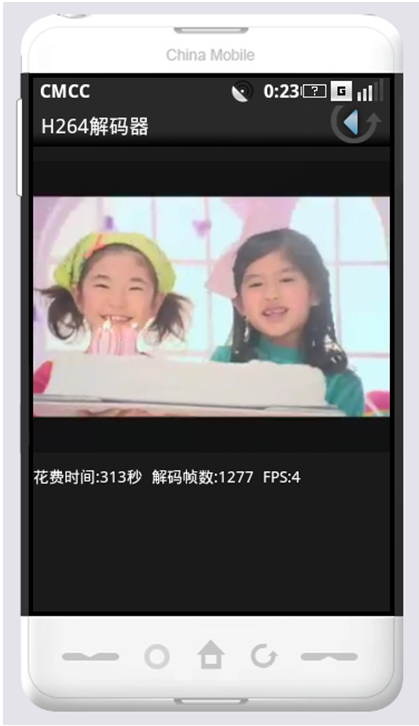
FAQ 3:
模擬器黑屏怎麼辦?
這可能是由於模擬器啟動速度比較慢所引起的,所以需要多等一會。希望下個版本能夠改進。